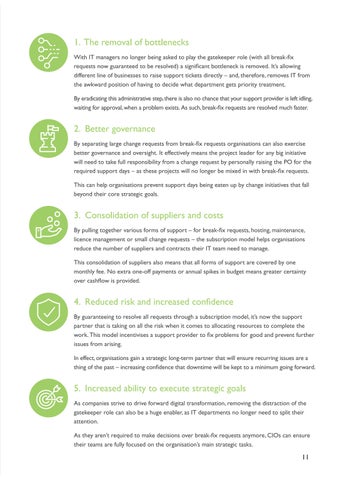1. The removal of bottlenecks With IT managers no longer being asked to play the gatekeeper role (with all break-fix requests now guaranteed to be resolved) a significant bottleneck is removed. It’s allowing different line of businesses to raise support tickets directly – and, therefore, removes IT from the awkward position of having to decide what department gets priority treatment. By eradicating this administrative step, there is also no chance that your support provider is left idling, waiting for approval, when a problem exists. As such, break-fix requests are resolved much faster.
2. Better governance By separating large change requests from break-fix requests organisations can also exercise better governance and oversight. It effectively means the project leader for any big initiative will need to take full responsibility from a change request by personally raising the PO for the required support days – as these projects will no longer be mixed in with break-fix requests. This can help organisations prevent support days being eaten up by change initiatives that fall beyond their core strategic goals.
3. Consolidation of suppliers and costs By pulling together various forms of support – for break-fix requests, hosting, maintenance, licence management or small change requests – the subscription model helps organisations reduce the number of suppliers and contracts their IT team need to manage. This consolidation of suppliers also means that all forms of support are covered by one monthly fee. No extra one-off payments or annual spikes in budget means greater certainty over cashflow is provided.
4. Reduced risk and increased confidence By guaranteeing to resolve all requests through a subscription model, it’s now the support partner that is taking on all the risk when it comes to allocating resources to complete the work. This model incentivises a support provider to fix problems for good and prevent further issues from arising. In effect, organisations gain a strategic long-term partner that will ensure recurring issues are a thing of the past – increasing confidence that downtime will be kept to a minimum going forward.
5. Increased ability to execute strategic goals As companies strive to drive forward digital transformation, removing the distraction of the gatekeeper role can also be a huge enabler, as IT departments no longer need to split their attention. As they aren’t required to make decisions over break-fix requests anymore, CIOs can ensure their teams are fully focused on the organisation’s main strategic tasks.
11




